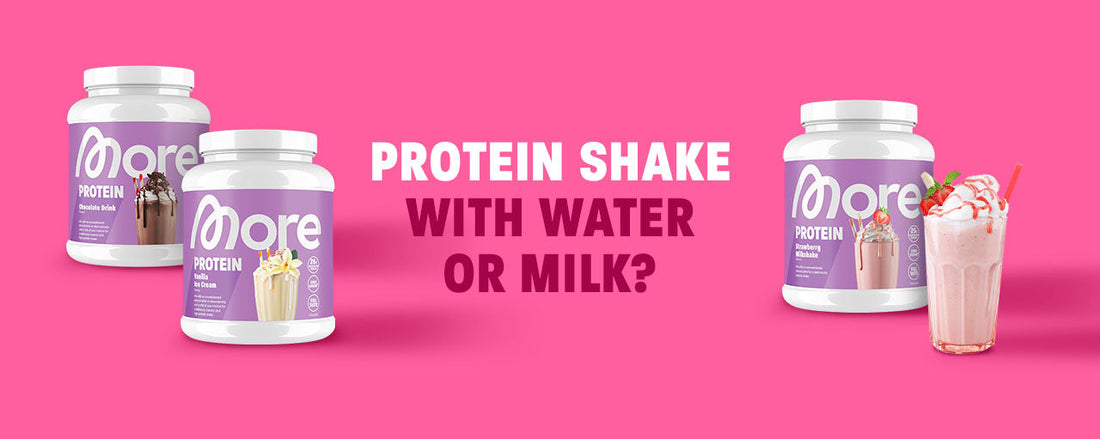
Proteïneshake met water of melk: wat is beter?
Er zijn zoveel verschillende manieren om je eiwitshakes te bereiden
Mensen die actief zijn in de fitnessbranche vragen zich vaak af of ze hun eiwitshake met melk of water moeten maken . De keuze is echter groter dan je zou denken. Er zijn talloze combinaties mogelijk , van water tot magere melk en plantaardige melkvervangers.
Welke component het beste is voor je shake , hangt vooral van jou af . Hoewel alle combinaties bepaalde voor- en nadelen hebben, moet je bij het kiezen van de juiste mix letten op de gewenste smaak en het soort dieet dat je volgt. Individuele toleranties zouden je keuze tussen water en melk of plantaardige alternatieven ook moeten vergemakkelijken.
Wil je je eiwitshake combineren met water of melk en ben je momenteel op dieet of calorieën aan het tellen, dan is de keuze snel gemaakt. In dat geval kun je beter water gebruiken. Aan de andere kant bieden verschillende melksoorten de mogelijkheid om nieuwe smaken toe te voegen en zelfs een simpele pre-workout shake om te toveren tot een ware smaakbeleving. De juiste bereidingswijze hangt vaak af van hoeveel koolhydraten je op dat moment wilt consumeren. Afhankelijk daarvan kun je vervolgens je eiwitinname afstemmen op je dieet en de juiste training. Dus: eiwitshake met water of melk - wat is beter? We vertellen je alles wat je moet weten.
[[Veelgestelde vragen]]
[ITEM-]
[Q-]Kun je shakes met water mengen? [-Q]
[A-]Shakes kunnen gemengd worden met (magere) melk, plantaardige melkvervangers, maar ook gemakkelijk met water. In combinatie met water is de eiwitshake niet alleen caloriearmer, maar ook sneller verteerbaar.[-A]
[-ITEM]
[ITEM-]
[Q-]Hoe drink je een proteïneshake op de juiste manier?[-Q]
[A-]Een eiwitshake kan 1-3 keer per dag worden gedronken. De portiegrootte staat aangegeven op de verpakking. Het beste is om de shake direct na het opstaan en voor of na de training te consumeren. De shake kan worden bereid met water, (magere) melk of een plantaardig melkalternatief.[-A]
[-ITEM]
[ITEM-]
[Q-]Hoe snel moet je een proteïneshake drinken?[-Q]
[A-]In tegenstelling tot eerdere aannames is er geen anabool venster na de training waarin de eiwitinname gegarandeerd moet zijn. Het is veel belangrijker om gedurende de dag voldoende eiwitinname te hebben, ook rond een training. [-A]
[-ITEM]
[ITEM-]
[Q-]Hoeveel calorieën bevat een proteïneshake met water?[-Q]
[A-]Omdat de calorieën in melk worden bespaard bij bereiding met water, bevat een eiwitshake met water logischerwijs minder calorieën. De calorieën variëren afhankelijk van de fabrikant, de eiwitvorm en de smaak. Een richtlijn voor een portie van 50 gram is ongeveer 180 calorieën.[-A]
[-ITEM]
[[-Veelgestelde vragen]]
Meer eiwitten & meer smaak? Maak een eiwitshake met melk.
Veel mensen vragen zich af: kun je eiwitshakes met melk drinken? Natuurlijk kan dat en het biedt je een aantal lekkere alternatieven voor water. Omdat er zoveel soorten melk op de markt zijn, wordt je als kenner echt variatie geboden. Terwijl sommige mensen liever verschillende smaken uitproberen, zijn er andere sporters en shakedrinkers die hun keuze willen baseren op het vetgehalte van de melk . Natuurlijk kun je zelf bepalen welke je wilt maken op basis van je smaak of doel. In principe is er voor ieder wat wils:
- volle melk met 3,5% vet
- Magere melk met 1,5% vet
- Magere melk / magere melk met 0,1 tot 0,5% vet
- Plantaardige melkalternatieven
Naast de genoemde opties kun je je eiwitshake ook mengen met lactosevrije melk . Zo kunnen sporters en shakedrinkers met lactose-intolerantie probleemloos van hun eiwitinname genieten. Gebruik je echter een product zoals onze MORE PROTEIN, dat lactase bevat, dan is het extra gemakkelijk, zelfs als je lactose-intolerant bent. Voor mensen die lactose moeilijk verteren, verbetert lactase simpelweg de lactosevertering. De hoeveelheid in MORE PROTEIN is zo gedoseerd dat je je shake zelfs met normale volle of magere melk kunt drinken.
[[PRODUCTEN-]]meer-eiwit-sonde,meer-eiwit,meer-duidelijke-eiwit[[-PRODUCTEN]]
Dit zijn de voordelen van eiwitshakes met melk
De voordelen van eiwitshakes met melk zijn talrijk. Melk geeft je eiwitshake niet alleen een intensere, vollere smaak , maar je krijgt na het mixen ook een hoger eiwitgehalte dan wanneer je het met water mengt. Eiwitshakes met melk hebben vaak ook een veel aangenamere consistentie en lijken daardoor meer op een echte milkshake, niet alleen qua smaak maar ook qua mondgevoel.
De combinatie van eiwitpoeder en melk kan in uw dieet een vullende bron van eiwitten vormen en, samen met wat fruit of noten, dienen als maaltijdvervanger , waardoor u tijd bespaart bij het bereiden van een maaltijd . Natuurlijk is een eiwitshake met melk geen algemene vervanging voor een evenwichtig dieet . Gezonde voedingsstoffen en vetten completeren de voordelen van melk als onderdeel van een shake. U vindt diverse extra voedingsstoffen in weidemelk die weinig bewerkt is .
Slecht voor calorietellers? De nadelen van eiwitshakes met melk
Ja, de smaak is goed. Eiwitshakes met melk hebben echter ook hun nadelen. Volle melk levert je shake aanzienlijk meer calorieën dan een combinatie met water. Calorietellers moeten hier dus rekening mee houden, afhankelijk van hun eetgewoonten . Bovendien geldt: hoe hoger het vetgehalte in de melk , hoe langzamer je lichaam voedingsstoffen kan opnemen .
Eiwitshakes met melk zijn vaak ook moeilijker te verteren. Dat je geen lactose-intolerantie ervaart in de vorm van significante spijsverteringsproblemen, betekent niet dat je lichaam geen moeite heeft met het verteren van lactose . Volgens recente studies heeft 65% van de volwassen wereldbevolking minstens een milde lactose-intolerantie . [$1]
Dit nadeel kan echter gecompenseerd worden, afhankelijk van de stoffen in het eiwitpoeder . Als de shake gecombineerd wordt met lactase, zoals bij MORE PROTEIN, wordt de spijsvertering van het lichaam normaal gesproken niet beïnvloed. Melk wordt echter gewoon langzamer verteerd. Als maaltijd is de combinatie behoorlijk vullend, maar kan tegelijkertijd ook onaangenaam aanvoelen in de maag tijdens de training . Dit is vooral het geval als de shake kort voor de training met melk is gedronken .
Als je melk in een eiwitshake mengt voor de smaak en toch je lichaam wilt beschermen en calorieën wilt besparen, kun je magere melk (ongeveer 30 kcal/100 ml) met minder vet gebruiken. Een plantaardig alternatief is bijvoorbeeld ongezoete amandelmelk (ongeveer 13 kcal/100 ml) , wat ook kan worden overwogen door calorietellers of mensen die een dieet volgen.
Over het algemeen zie je duidelijk dat de eiwitshake met melk vooral geschikt is als je hem wilt drinken als gezondere vervanger van snoep zonder toevoegingen of als je er gewoon van wilt genieten vanwege de smaak. Het is vergelijkbaar met een gewone milkshake. Hoewel hij veel natuurlijke eiwitten bevat en spierbehoud en -opbouw zou moeten ondersteunen , is hij niet voor iedereen de juiste keuze. Vooral mensen die willen afvallen, zouden beter voor het wateralternatief kunnen kiezen.
Minder calorieën en minder smaak? Maak eiwitshakes met water.
Kun je eiwitshakes met water drinken? Versterkt water de werking van de eiwitten? Bij het bereiden van eiwitshakes stel je jezelf altijd de vraag: doe ik het wel goed? Er is geen goed of fout. Als je eiwitshakes met water bereidt, zijn er net zoveel voor- en nadelen als wanneer je ze met melk bereidt . Je hebt in principe alleen vloeistof nodig om een eiwitshake te mixen. Water kan dus zonder problemen gebruikt worden.
De redenen om eiwitpoeder en melk te combineren variëren. De meeste mensen letten op calorieën en geven daarom de voorkeur aan een iets lichtere smaak . Als je eiwitpoeder met water of melk wilt mengen en vanwege een intolerantie besluit water te gebruiken, kun je dit vermijden. Eiwitpoeder met lactase kan helpen bij lactose-intolerantie en zorgt zo voor een aangename smaak, zelfs in combinatie met melk . Als je daarentegen een streng dieet volgt, is mengen met water wellicht beter voor je.
Wat zijn de voordelen van het mengen van proteïneshakes met water?
Het meest voor de hand liggende voordeel: in tegenstelling tot melk is water extreem goedkoop en bijna overal verkrijgbaar. Bovendien is water gegarandeerd goed te verdragen en kunnen eiwitpoeders zonder lactase ook probleemloos worden getest. Een eiwitshake met water levert door de samenstelling geen extra calorieën op en is daarom ideaal voor mensen die extra aandacht willen besteden aan hun lijn. Omdat water minder viskeus is dan melk, kan dit een voordeel zijn bij poeder dat moeilijk oplost.
Dit betekent vaak dat er minder klontjes ontstaan. Bij hoogwaardige eiwitpoeders zijn er echter geen problemen met de oplosbaarheid in melk of water. Eiwitpoeder opgelost in water is ook sneller te verteren dan vette melk , wat betekent dat het lichaam de voedingsstoffen iets sneller opneemt . In de praktijk is dit feit echter te verwaarlozen. Dus als je je eiwitten met water of melk wilt mengen en het niet zeker weet, moet je altijd de voor- en nadelen van beide componenten bekijken . Terwijl melk misschien geschikter is om te feesten, biedt water het voordeel van een bijzonder lichte eiwitshake en is het geschikt voor calorietellers en om af te vallen met eiwitpoeder . Het effect op spieren en spieropbouw tijdens de training wordt natuurlijk niet beïnvloed door het te bereiden met water.
Flauwe smaak en minder voedingsstoffen: wat zijn de nadelen van proteïneshakes met water?
Het belangrijkste argument tegen het bereiden van een eiwitshake met water is waarschijnlijk de smaak . Veel shakedrinkers vinden dat de combinatie met water de smaak sterk beïnvloedt en, in tegenstelling tot melk, niet bijdraagt aan het aroma van de shake. Dit kan echter verklaard worden doordat het poeder een bepaalde smaakkwaliteit moet hebben. Is dit niet het geval, dan voelt de smaak in combinatie met water erg flauw aan en verdwijnt het voordeel van de lage calorieën al snel naar de achtergrond.
Bij de afweging of een eiwitshake beter gemengd kan worden met melk of water, kun je ook kijken naar de voedingsinname . Het nadeel van het bereiden met water is dat er geen extra voedingsstoffen worden opgenomen. De juiste keuze moet dus individueel worden gemaakt, afhankelijk van je dieet of voedingspatroon .
Wei of caseïne: Kun je elk proteïnepoeder met water of melk mengen?
Het mengen van wei-eiwitpoeder met water of melk is meestal geen probleem. Een poeder met caseïne of een combinatie is ook een prima manier om het te bereiden. Als combinatie kunnen wei en caseïne de goede eigenschappen van beide eiwitten combineren en je lichaam optimaal ondersteunen. In onze MORE PROTEIN proef je het niet alleen, maar profiteer je ook van alle voordelen van beide eiwitten . Kies eenvoudig je persoonlijke favoriet.
Terwijl wei je shake vloeibaarder maakt, geeft caseïne hem een romige consistentie . Je kunt het eiwitpoeder dus mengen afhankelijk van de smaak en consistentie die je wilt bereiken . De combinatie van melk en caseïne zorgt meestal voor het romigste resultaat . Maar wees voorzichtig: bij het mengen van het poeder moet je onderscheid maken tussen caseïnaat en micellaire caseïne . Caseïnaat geeft een luchtige, romige consistentie, terwijl micellaire caseïne snel dik wordt en klontjes kan vormen. Vermijd dergelijke nadelen door de samenstelling van het eiwitpoeder goed te bekijken voordat je een keuze maakt.
Een van de voordelen van wei-eiwit is dat het snel door het lichaam wordt opgenomen en dit effect kan worden versterkt in combinatie met water . Weipoeder is daarom soms uitsluitend verkrijgbaar voor bereiding met water . Zulke combinaties lijken echter over het algemeen minder op een echte eiwitshake en lijken qua consistentie meer op een vruchtendrank . Andere wei-eiwitshakes werken echter prima met water of melk. Om de juiste keuze te maken voor jou, je dieet en je doel, kun je ook verschillende producten en combinaties uitproberen. Je merkt gegarandeerd snel wat het beste is voor jouw lichaam, spieren en figuur.
De middenweg: meng eiwitshakes met water en melk
Wie had dat gedacht - als je wilt profiteren van de voordelen van zowel melk als water , kun je beide componenten zelfs mengen met je eiwitpoeder . In plaats van je eiwitshake met water of melk te bereiden, kun je beide vloeistoffen gewoon mengen in een verhouding van 50:50 of 70:30. Zo zorg je voor een goede smaak met minder calorieën.
Als je water en melk mengt , zal je eiwitshake meer melkachtig smaken. Koolhydraten en vet blijven echter behouden . Je zult nauwelijks verschil merken , vooral bij shakes die caseïne bevatten. In tegenstelling tot wei-eiwit garandeert caseïne een dikkere, romigere consistentie en zorgt het voor een volle smaakbeleving ondanks het watergehalte . Nog een belangrijk punt: de combinatie van de twee componenten zorgt ervoor dat je minder vol zit en dus ook minder vol in je maag zit, zelfs als je al lang niet meer hebt getraind .
Geef je de voorkeur aan een proteïneshake met water of melk? Het hangt allemaal af van de bereiding!
Beslissen of je je shake met water of melk wilt mixen, is de eerste stap naar een succesvolle smaakbeleving en je persoonlijke doel . Er zijn echter extra ingrediënten die je in combinatie kunt gebruiken om de smaak te personaliseren . Het simpelweg mengen van het eiwitpoeder met melk of water is vooral de moeite waard wanneer je haast hebt en bijvoorbeeld bijna gaat trainen. We willen je echter graag een paar methoden laten zien om je shake wat meer pit te geven als het wat langer kan duren:
- Geniet gewoon van je proteïneshake ijskoud . Koude melk of koud water heeft niet alleen een positief effect op de smaak , maar zorgt ook voor een aangename frisheid , vooral in de zomer. Onze insidertip: meng er ijsblokjes doorheen . Als je je shake in de Blender Bottle® met ijsblokjes bereidt, wordt hij nog romiger .
- Eiwit- en cafeïnekick: Vooral bij het ontbijt kun je koude of warme koffie als basis voor je shake gebruiken. Als je warme koffie kiest, meng het eiwitpoeder dan niet in de shaker - anders loop je het risico je te verbranden.
- Vul het aan als maaltijdvervanger met andere zuivelproducten en voedingsmiddelen . Ook als je je eiwitshake liever met water of melk drinkt, kun je verschillende recepten uitproberen met kwark of yoghurt , fruit of noten en je eiwitten niet alleen als eiwitshake gebruiken, maar ook op een heel andere manier.
Recepten voor heerlijke eiwitshakes met melk of water
Eiwitshakes zijn niet alleen een goede snack tussen de maaltijden door , ze zijn ook een veelzijdige maaltijdvervanger . Door eiwitshakes niet alleen met melk of water te combineren, maar ook andere ingrediënten uit te proberen, leer je snel verschillende recepten kennen en ontdek je zelf het een en ander. Onze recepten bieden je voedingsrijke shakes die rijk zijn aan eiwitten en tegelijkertijd heerlijk smaken . Om je dieet te verfrissen zonder je schuldig te voelen, bieden we je de mogelijkheid om extra calorieën uit suiker en dergelijke te besparen met onze MORE PROTEIN en de smaak van de CHUNKY FLAVOR -varianten en toch zoete, gevarieerde drankjes te combineren met je fitnessroutine .
![[shipping]](http://nl.morenutrition.com/cdn/shop/files/Truck_fb68f857-ef5e-4f72-8714-7f5bdb40a16a.png?v=1754667121&width=100)



